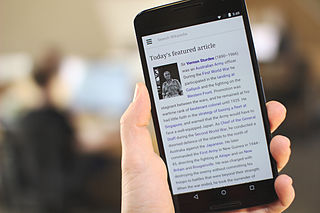
A smartphone is a mobile device that combines the functionality of a traditional mobile phone with advanced computing capabilities. It typically has a touchscreen interface, allowing users to access a wide range of applications and services, such as web browsing, email, and social media, as well as multimedia playback and streaming. Smartphones have built-in cameras, GPS navigation, and support for various communication methods, including voice calls, text messaging, and internet-based messaging apps.

Near-field communication (NFC) is a set of communication protocols that enables communication between two electronic devices over a distance of 4 cm or less. NFC offers a low-speed connection through a simple setup that can be used for the bootstrapping of capable wireless connections. Like other proximity card technologies, NFC is based on inductive coupling between two electromagnetic coils present on a NFC-enabled device such as a smartphone. NFC communicating in one or both directions uses a frequency of 13.56 MHz in the globally available unlicensed radio frequency ISM band, compliant with the ISO/IEC 18000-3 air interface standard at data rates ranging from 106 to 848 kbit/s.

Solo Mobile is a discontinued mobile virtual network operator in Canada started by Bell Mobility in 2000. Historically, Solo was considered a discount wireless brand, offering low price monthly plans with some unlimited options in certain cities. Its products and services were only sold in British Columbia, Alberta, Ontario and Quebec. The brand ceased advertising towards new customers since November 2011, and new activations were officially discontinued on May 17, 2012.

My5 is the brand name of video-on-demand services offered by Channel 5 in the United Kingdom. The service went live on 26 June 2008. It is owned by Paramount Global and operated by their Paramount Networks UK & Australia division.
A mobile operating system is an operating system used for smartphones, tablets, smartwatches, smartglasses, or other non-laptop personal mobile computing devices. While computers such as typical/mobile laptops are "mobile", the operating systems used on them are usually not considered mobile, as they were originally designed for desktop computers that historically did not have or need specific mobile features. This "fine line" distinguishing mobile and other forms has become blurred in recent years, due to the fact that newer devices have become smaller and more mobile, unlike the hardware of the past. Key notabilities blurring this line are the introduction of tablet computers, light laptops, and the hybridization of the two in 2-in-1 PCs.

ITVX is a British over-the-top and ad-supported streaming service operated by ITV plc. The service offers original content from the broadcaster, livestreams of the ITV television channels, FAST channels, and exclusive and licensed programming.

Samsung Galaxy is a series of computing and Android mobile computing devices that are designed, manufactured and marketed by Samsung Electronics since 29 June 2009. The product line includes the Samsung Galaxy S series of high-end phones, Galaxy Z series of high-end foldables, Galaxy A series, Samsung Galaxy Ace, Galaxy F series and Galaxy M series of mid-range phones, the Galaxy Book of laptops, the Samsung Galaxy Tab series, the Samsung Galaxy Watch series, the Galaxy Buds series and the Galaxy Fit, and the now historical Galaxy Note series of pioneering phablets.

The Samsung Omnia II GT-I8000(H/L/U) is a multimedia smartphone announced at Samsung Mobile Unpacked on June 15, 2009. Earlier Omnia II releases run Windows Mobile 6.1, however they are upgradable to version 6.5 Professional. There is also an unofficial and experimental Android version available. Verizon is the official US carrier for this phone and released it in December 2009.
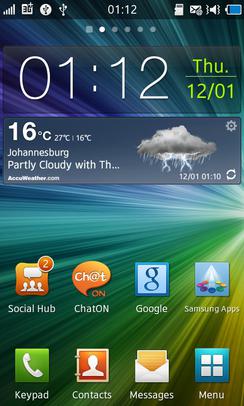
Bada was a mobile operating system developed by Samsung Electronics for devices such as mid- to high-end smartphones and tablet computers. The name is derived from "바다 (bada)", meaning "ocean" or "sea" in Korean. All phones running Bada were branded with the name Wave, unlike Samsung's Android devices which are branded as Galaxy.
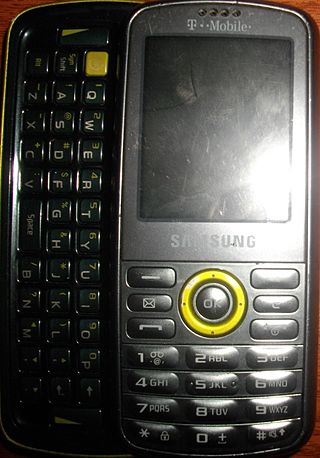
The Samsung Gravity (SGH-T459) is a slider feature phone with a full QWERTY keypad. It was first released for T-Mobile USA. The Samsung SGH-T349 is a mobile phone available through T-Mobile and announced on May 20, 2009 that has many similarities to the original Gravity.
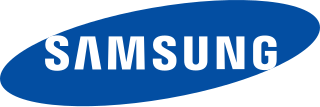
The Samsung Wave S8500 is a smartphone developed and produced by Samsung Electronics. It is the first smartphone to run the Bada operating system developed by Samsung Electronics, which was commercially released on May 24, 2010. The Wave is a touchscreen phone powered by Samsung's "Hummingbird" CPU (S5PC110), which includes 1 GHz ARM Cortex-A8 CPU and a built-in PowerVR SGX 540 graphics engine. It also has a "Super AMOLED" screen and 720p high-definition video capture capabilities. Due to shortage of Super AMOLED screens, Samsung released a successor to the device called Wave II and ceased production of the original S8500 model.

A smartwatch is a portable wearable computer that resembles a wristwatch. Most modern smartwatches are operated via a touchscreen, and rely on mobile apps that run on a connected device in order to provide core functions.
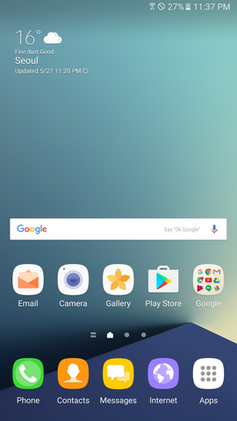
TouchWiz is a discontinued user interface developed by Samsung Electronics with partners, featuring a full touch user interface. It is sometimes incorrectly referred to as an operating system. TouchWiz was used internally by Samsung for smartphones, feature phones and tablet computers, and was not available for licensing by external parties. The Android version of TouchWiz also comes with the Samsung-made app store Galaxy Apps. It was replaced by Samsung Experience in 2017 with the release of Android 7.0 "Nougat".

Tizen is a Linux-based operating system primarily developed by Samsung Electronics and supported by the Linux Foundation.

The Samsung Galaxy S III is an Android smartphone developed and marketed by Samsung Electronics. Launched in 2012, it had sold more than 80 million units overall, making it the most sold phone in the S series. It is the third smartphone in the Samsung Galaxy S series.

A phablet is a mobile device combining or straddling the size formats of smartphones and tablets. The word is a blend word of phone and tablet. The term was largely unused by the late 2010s, since average phone sizes eventually morphed into small tablet sizes, up to 6.9 inches (180 mm), with wider aspect ratios.
The Samsung SGH-T669 is a 3G-capable smartphone manufactured by Samsung. In the US it is also called the Samsung Gravity T; in Canada, the Samsung Gravity Touch.

The Samsung Galaxy S4 is an Android smartphone produced by Samsung Electronics as the fourth smartphone of the Samsung Galaxy S series and was first shown publicly on March 14, 2013, at Samsung Mobile Unpacked in New York City. It is the successor to the Galaxy S III, which maintains a similar design, but with upgraded hardware, more sensors, and an increased focus on software features that take advantage of its hardware capabilities—such as the ability to detect when a finger is hovered over the screen, and expanded eye tracking functionality, it was released the previous year. A hardware variant of the S4 became the first smartphone to support the emerging LTE Advanced mobile network standard. The T-Mobile version of the Galaxy S4, named the model (SGH-M919), was released the same month. The phone's successor, the Samsung Galaxy S5, was released the next year.
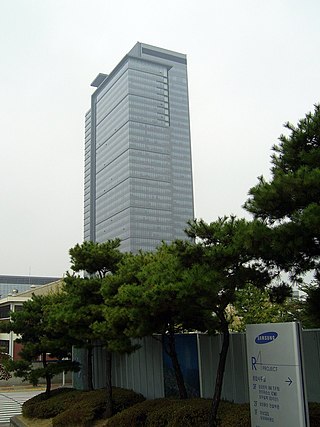
Samsung Electronics Co., Ltd. is a South Korean multinational major appliance and consumer electronics corporation founded on 13 January 1969 and headquartered in Yeongtong District, Suwon, South Korea. It is currently the pinnacle of the Samsung chaebol, accounting for 70% of the group's revenue in 2012, and has played a key role in the group's corporate governance due to cross ownership. It is majority-owned by foreign investors.
The Samsung Wave 3 S8600 is a smartphone running the Bada 2.0 operating system designed by Samsung, which was commercially released in August 2011. The Wave is a slim touchscreen phone powered by "Scorpion" CPU, which includes 1.4 GHz ARM Cortex-8 CPU and a powerful graphics engine, "Super LCD" screen and 720p high-definition video capture capabilities. Shortage of Super AMOLED screens was one of the primary reasons for the release of this model.
















